An innovative water-saving irrigation system developed in Tunisia is providing a viable solution to drought situations experienced by olive producers.
The inventor, Bellacheb Chahbani, was a researcher at the Institut Tunisien des Régions Arides for 25 years, before setting up his own company, ChahTech, to market his water-saving irrigation system.
Chahbani’s award-winning invention was inspired by an irrigation method which was used by his grandfather. He would bury a porous earthenware jar filled with water at the foot of trees so that the water could slowly permeate into the earth. Unfortunately the fragile jars would often end up breaking.
Chahbani’s irrigation system uses plastic water diffusers which are buried underground. After digging four holes at the base of a tree, a diffuser is buried in each hole at a depth of about 50 to 70 cm (20 – 28 inches), at root level.
The plastic diffusers are connected to a network of buried tubes linked to a main pipe connected to an elevated tank. When water is released, the diffusers fill with water. A meter keeps track of the volume of water, generally 10 cubic meters for each tree.
With this economical system, the tree only needs to be watered once a year because the water is contained in the soil, irrigating the tree through the holes in the bottom of the diffuser only when the tree needs it. If it rains, the water stored in the earth can be used the following season.
The system has been successfully tested on olive groves affected by drought in arid regions of Tunisia where water scarcity is a pressing issue.
Compared to a drip irrigation system, the diffuser system uses up to 40 percent less water and requires less maintenance. Another advantage is that it doesn’t provide nourishment to weeds because the diffusers are buried too deep to provide water at ground level.








